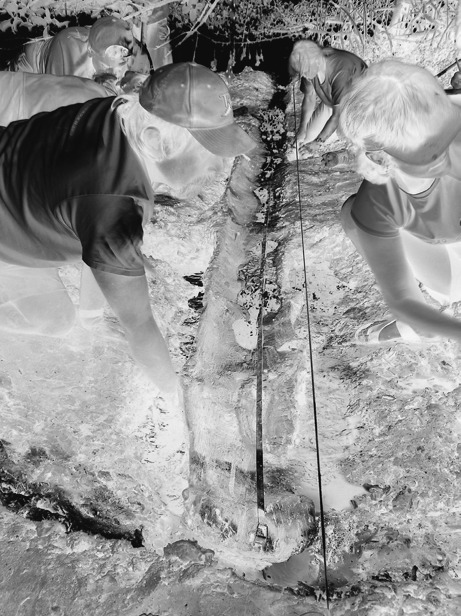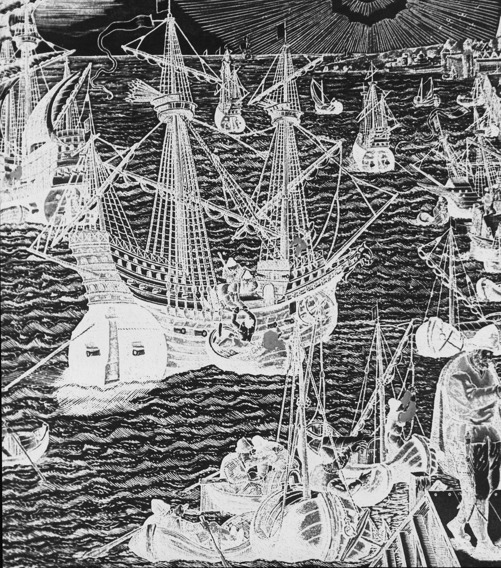The History of Florida (82 page)
Read The History of Florida Online
Authors: Michael Gannon
Tags: #History, #United States, #State & Local, #Americas

river channels that once ran to the ancient coastline.
As sea levels rose over thousands of years, Florida’s landmass changed,
becoming the shape we are familiar with today. The first Floridians utilized
the coasts to obtain maritime resources, such as fish and shellfish, for food
and tools. Inland freshwater springs continued to be of major importance,
and evidence of native use can stil be found in many spring basins and sink-
holes. For example, at Little Salt Spring hundreds of objects made of wood,
shel , bone, and stone have been recovered and provide information about
· 389 ·

390 · Del a A. Scott-Ireton and Amy M. Mitchell-Cook
proof
Prehistoric canoes, such as this one recovered near Weedon Island,
often are found along Florida’s waterways. Courtesy of the Pinellas
County Communications Department.
the people who lived around the spring in the late Paleoindian and early
Archaic Periods (11,400–10,200 YBP [Years Before Present]). One especial y
amazing artifact appears to be an early calendar with incised markings rep-
resenting the days of the month, one of the earliest date-keeping tools ever
discovered in North America.
Watercraft appeared in Florida as early as the middle to early Archaic
Period (at least 7,000 to 6,000 YBP); although earlier watercraft probably
existed, archaeological evidence has not yet been found. Some Archaic ves-
sels have been discovered, however, and currently more than 300 wooden
dugout canoes have been identified in the state. Primarily discovered during
The Maritime Heritage of Florida · 391
droughts when lakes dry up and river levels are low, canoes offer a rare
glimpse of the first maritime activity in Florida. For example, in the sum-
mer of 2000, a severe drought exposed dozens of prehistoric canoes in
Newnan’s Lake near Gainesville. With assistance from volunteers and stu-
dents, archaeologists recorded canoes in a two-mile stretch of the exposed
lake bed—the largest group of prehistoric canoes found to date in North
America. About 75 percent of the watercraft dated to the late Archaic or
early Woodland Periods in Florida’s history, or approximately 2,300 to 5,000
years ago. The location of the finds was named the Lake Pithlachocco Canoe
Site after an early Creek or Seminole name for Newnan’s Lake, appropriately
meaning “boat house.” Ranging in length from about 15 feet to a little over
30 feet, al of the canoes were manufactured from solid logs using fire to
char the wood and shell or stone tools to scrape the burned portions away.
Probably associated with a vil age site on the lake shore, the canoes likely
were abandoned when they became worn out, and in fact many showed
evidence of wear and damage.
Early European explorers noted the indigenous watercraft they saw, de-
scribing them as seaworthy, agile, and expertly handled. Used for fishing
and transport, the canoes carried native Florida peoples around the coast
and throughout the interior. Wooden watercraft continued to be made and
proof
used by native Floridians into the contact, exploration, and colonization
eras. Today, the native Floridian tradition of paddle-propel ed watercraft
survives. Seminoles stil living in the Everglades preserve their ancestors’
maritime skil s in canoe construction and handling. Additional y, the clear,
shallow, slow-flowing creeks of Florida’s interior draw tens of thousands of
visitors and residents to spend relaxing summer days in modern canoes.
European Contact and Colonization
On 7 June 1494, the Kingdom of Spain claimed Florida and all of the newly
discovered and as-yet-undiscovered lands of the Americas as part of the
Treaty of Tordesil as. The treaty, proposed by the pope, split the world down
a line drawn about halfway between the Cape Verde Islands and the Carib-
bean islands. The Portuguese claimed lands east of the line, which included
India and the rich spice islands of Malaysia, while the Spanish looked for-
ward to sole control of the New World on the western side of the line. The
treaty was, however, ignored by other European nations such as England,
France, and the Netherlands, setting the stage for centuries of dispute, war-
fare, and colonial competition.

392 · Del a A. Scott-Ireton and Amy M. Mitchell-Cook
Spanish explorers soon expanded from the islands of the Caribbean into
the heart of the New World. This expansion was, of course, enabled by water-
borne transport. Within a few years, the Spanish developed a regular route
between Spain and its New World colonies, called the Carrera de Indias, or
the “Indies run.” This round-trip voyage began in Spain with a convoy of
ships carrying manufactured materials, clothing, horse tack, foods, books,
and other goods that were in great demand in the colonies. After deliver-
ing the cargo to New Spain (Mexico), the ships took on spices, dyestuffs,
precious metals, and exotic and expensive products of the colonies for the
return voyage. Ideal y, the fleet made the round-trip each year, avoiding the
proof
New World fleets of the sixteenth century included vessels of different types and sizes,
as shown in this 1594 engraving. Courtesy of the University Press of Florida.
The Maritime Heritage of Florida · 393
late summer and fall season in the Caribbean that often brought hurricanes
and tropical storms.
The large landform bounding the Gulf of Mexico to the east was largely
unknown to the Spanish through the first decade of the sixteenth century.
As explained in chapter 2, conquistador Juan Ponce de León general y is
credited with European discovery of La Florida
,
named in part to honor the
Easter season. Although Juan Ponce’s first colonizing mission to La Florida
proved unsuccessful, the Spanish Crown realized the need for establishing
a permanent settlement in the newfound land. Other nations, including
France and England, made uncontested forays into Spanish New World
territory because no Spanish settlements or troops were there to prevent
them. Further, a permanent settlement on the coast would provide aid to
shipwrecked sailors. During the first half of the sixteenth century, explor-
atory voyages along the Gulf coast, including Pánfilo de Narváez in 1528 and
Hernando de Soto in 1539, identified spacious harbors and sheltered bays.
One bay in particular seemed especial y well suited for a settlement, with
deep water close to shore to facilitate loading cargo, good holding ground
for anchored ships, and sheltering land to provide calm mooring. Cal ed
Ochuse or Polonza on early maps, the Spanish renamed it Bahía Filipina del
Puerto de Santa María; today the harbor is called Pensacola Bay.
proof
Don Tristán de Luna y Arel ano led a colonizing mission to Bahía Fili-
pina, which included families, slaves, Aztec mercenaries, livestock, and all
the tools, equipment, and supplies to found a Spanish city on the edge of
the empire. Leaving New Spain, Luna’s fleet of eleven ships arrived in Pen-
sacola in August 1559 with plans to clear land and construct houses for the
settlers. Only a month later, however, a powerful hurricane struck the fledg-
ling colony and sank most of the ships in the fleet and, with those losses,
any chance for a successful colony. The survivors salvaged what they could
from the wrecked ships, but, suffering from food shortages and privation,
most marched north into the interior to try to obtain food from the native
peoples. Failing to find adequate supplies, the survivors eventual y returned
to Pensacola and were evacuated back to New Spain. The Spanish did not
return to Pensacola for more than a hundred years; in the meantime, the
Spanish founded a permanent settlement in 1565 at St. Augustine on the east
coast.
After Luna’s failure on the Gulf coast of Florida, Don Pedro Menéndez de
Avilés came to the Atlantic coast to accomplish the same goals of consoli-
dating Spanish control, protecting the route of the treasure fleets, and aid-
ing shipwrecked sailors. Menéndez also had an ambitious plan to establish
394 · Del a A. Scott-Ireton and Amy M. Mitchell-Cook
mines and profitable agriculture, and, like other conquistadores, convert the
native peoples to Christianity; he also hoped to find his son, lost in an earlier
shipwreck on Florida’s coast. Establishing Spanish control was especial y
crucial in east Florida because, in 1562, a French Protestant (Huguenot) ex-
pedition under Jean Ribault explored the area around St. Augustine before
founding the settlement of Charlesfort in present-day South Carolina. A
second French incursion in 1564 landed a small garrison at Fort Caroline
on the St. Johns River, which the Spanish destroyed. Menéndez’s flagship
San
Pelayo
, along with four additional vessels, arrived off the coast on 8 Sep-
tember 1556 carrying colonists to found the first successful European town
in what is now the United States. Despite hurricanes, disease, and attacks
by English privateers, St. Augustine remains the nation’s oldest continual y
inhabited city and port. Situated on a strategic harbor and relying on ships
to bring supplies and additional settlers, St Augustine’s maritime focus was
reinforced by the construction of the Castillo de San Marcos in 1672–95.
Among the most exciting recent discoveries connected to these early
Spanish maritime ventures in Florida was the finding of two ships from
Luna’s lost fleet. The only remains known to be associated with a Spanish
colonization effort, these ships reveal information about seafaring in the
Age of Discovery and Exploration and about the process of transporting
proof
an entire culture into a wilderness. State of Florida archaeologists discov-
ered the first ship, called the Emanuel Point Ship (EPI) in 1992. Excavations
revealed clues to colonial plans including ceramic containers for food and
water, evidence of the Aztec mercenaries, butchered bones from cattle and
swine, leather shoe soles, and hundreds of olive pits. The University of West
Florida’s maritime archaeology program in 2006 discovered the second ves-
sel, Emanuel Point II (EPII), only 400 yards away from the first vessel. A
smal er ship than EPI, EPII contained an array of ceramic items, as well
as shafts for crossbow bolts and even bones from the ship’s cat that likely
perished in the wrecking.
Although Spain staked its claim to La Florida with a permanent settle-
ment at St. Augustine, its hold was tenuous at best. To strengthen the claim,
in 1698 a second colony was founded at Pensacola, located directly to the
north of the pass leading into the bay from the Gulf, on today’s Naval Air
Station Pensacola, and cal ed Presidio Santa María de Galve. Although
Santa María had little to recommend it, the area boasted dense pine and
live oak forests that provided ideal materials for ship construction and naval
stores such as pitch and resin. From the early sixteenth century, shipyards in
The Maritime Heritage of Florida · 395
the New World took advantage of virgin forests and a profusion of natural
resources to produce merchant vessels, warships, and a host of smaller wa-
tercraft. Although none of these ships survive, a few shipwrecks from this